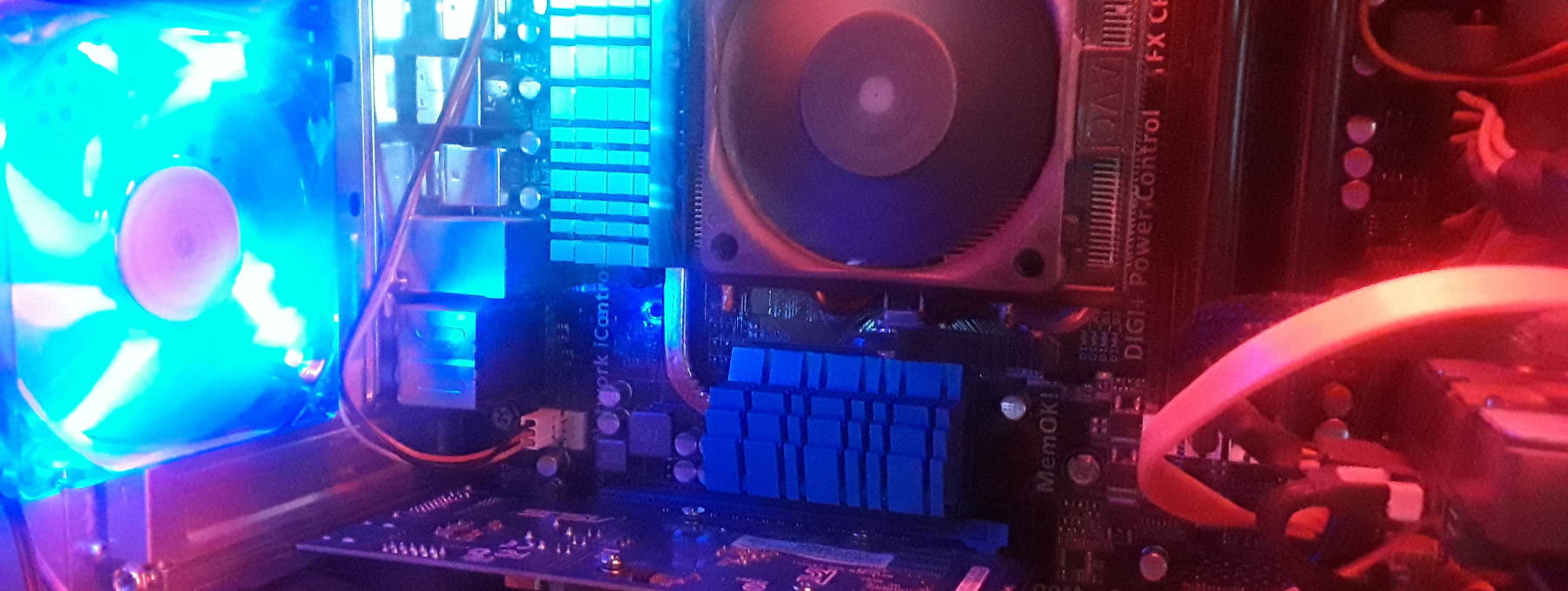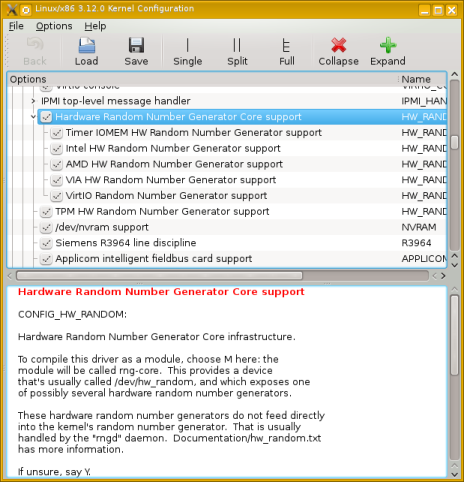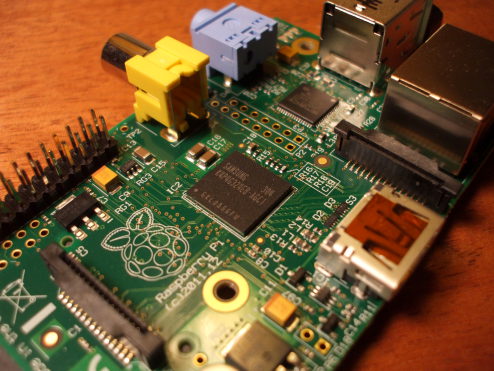
Linux /dev/random and Other Sources of Entropy
Random Data on Linux
(And Other UNIX-Family Operating Systems)
A number of scientific, engineering, and cybersecurity tasks need random data. We need them for scientific applications including Monte Carlo methods for simulating complex physical processes. We need to generate random noise signals in order to test digital signal processing techniques. Finally, several cryptographic tasks need unpredictable, thus unguessable, data. These include long-term RSA and ECC key pairs for SSH and PGP, one-use-only session keys for encrypting SSH and TLS/SSL connections and for encrypting stored data, and the initialization vectors used for the various chaining and feedback modes of symmetric block ciphers.
The problem is that a computer is a completely deterministic device. If you run the same program multiple times it should do the same thing each time. Otherwise it would have a serious problem. A computer program is instead a pseudorandom generator. John von Neumann said "Anyone who considers arithmetical methods of producing random digits is, of course, in a state of sin."
An older way of generating a pseudorandom sequence on a
Unix-family operating system
(Linux,
BSD,
Apple OS X, Solaris, etc., is to first seed the
sequence generator with srand() and then
repeatedly call rand() to obtain the sequence.
The problem is that the output is too regular.
The GNU manual page describes these library calls bluntly:
NAME
rand, srand - bad random number generator
SYNOPSIS
#include <stdlib.h>
void srand(unsigned int seed);
int rand(void);
int rand_r(unsigned int *seed);
[...]
As the GNU manual page explains,
rand() and srand() first
appeared in Version 3 AT&T UNIX and conform to
ANSI C89 (ANSI X3.159-1989).
The low dozen bits go through a cyclic pattern.
Things were different then.
The Solaris manual page is a little more kind but still makes the point that these old functions are not good:
USAGE
The spectral properties of rand() are limited. The
drand48(3C) function provides a better, more elaborate
random-number generator.
The functions srandom() and random()
seed and then generate a sequence with much better
characteristics.
The GNU manual page for random() explains
that it uses a non-linear additive feedback random
number generator with a period of approximately
16×(231-1) or 34,359,738,352.
For Monte Carlo simulations or digital signal processing, you just need pseudorandom data with the desired distribution. In fact, it may be preferred because you get the same sequence every time you start with the same seed.
However, security applications need truly unpredictable random numbers for purposes including the generation of cryptographic keys. This leads to the concept of a cryptographically strong pseudorandom number generator, something that makes it adequately difficult to predict the next values even after observing the sequence so far. These unpredicatable sequences could be used to generate long-term SSH keys for servers and users, SSL keys for servers, or the session keys used to encrypt sensitive files or e-mail messages.
A more mundane (and therefore frequently overlooked) need is for unpredictable TCP initial sequence numbers and DNS transaction ID numbers. The TCP risks were pointed out by Robert Morris in 1985 and Steven Bellovin in 1989, but we still had problems into the 2000s with operating systems implementing TCP in a way that allowed attackers to hijack connections. The DNS problems are more recent, with RFC 5452 suggesting some interesting extensions.
Random Devices
Linux was the first operating system to include a
pseudo-device producing pseudorandom data seeded by
sources of entropy or true randomness.
The Solaris manual page for the random
device says:
"An implementation of the /dev/random and /dev/urandom
kernel-based random number generator first appeared
in Linux 1.3.30."
Other Unix-family operating systems have since added them.
The Linux random(4) manual page describes
these pseudo-devices as follows:
The random number generator gathers environmental noise from device drivers and other sources into an entropy pool. The generator also keeps an estimate of the number of bits of noise in the entropy pool. From this entropy pool random numbers are created.
When read, the /dev/random device will only return random bytes within the estimated number of bits of noise in the entropy pool. /dev/random should be suitable for uses that need very high quality randomness such as one-time pad or key generation. When the entropy pool is empty, reads from /dev/random will block until additional environmental noise is gathered.
A read from the /dev/urandom device will not block waiting for more entropy. As a result, if there is not sufficient entropy in the entropy pool, the returned values are theoretically vulnerable to a cryptographic attack on the algorithms used by the driver. Knowledge of how to do this is not available in the current unclassified literature, but it is theoretically possible that such an attack may exist. If this is a concern in your application, use /dev/random instead.
That same manual page continues with some guidelines for using these kernel features:
If you are unsure about whether you should use /dev/random or /dev/urandom, then probably you want to use the latter. As a general rule, /dev/urandom should be used for everything except long-lived GPG/SSL/SSH keys.
[...]
The amount of seed material required to generate a cryptographic key equals the effective key size of the key. For example, a 3072-bit RSA or Diffie-Hellman private key has an effective key size of 128 bits (it requires about 2^128 operations to break) so a key generator only needs 128 bits (16 bytes) of seed material from /dev/random.
While some safety margin above that minimum is reasonable, as a guard against flaws in the CPRNG algorithm, no cryptographic primitive available today can hope to promise more than 256 bits of security, so if any program reads more than 256 bits (32 bytes) from the kernel random pool per invocation, or per reasonable reseed interval (not less than one minute), that should be taken as a sign that its cryptography is not skillfully implemented.
Devices and Kernel Data Structures
The Linux kernel data structures in
/proc/sys/kernel/random/* provide an additional
interface to the /dev/random device.
The read and write wakeup thresholds can be changed by
writing to those files, the other values are read-only.
All can be read by cat or sysctl.
boot_id |
Random string generated at boot time. |
entropy_avail |
The number of bits of available entropy. |
poolsize |
The size of the entropy pool, the maximum
size of entropy_avail.
|
read_wakeup_threshold |
The number of bits of entropy required for
waking up processes that sleep waiting for
entropy from /dev/random.
|
uuid |
Random UUID string generated afresh at each read. |
write_wakeup_threshold |
The number of bits of entropy below which we
wake up processes that do a
select() or
poll() for
write access to /dev/random.
|
Below we check on the random devices available in various UNIX-family operating systems.
% uname -a ; ls -l /dev/*random* Linux linux.example.org 3.12.0 #1 SMP Sun Nov 3 19:58:07 EST 2013 x86_64 x86_64 x86_64 GNU/Linux crw-rw-rw- 1 root root 1, 8 Nov 3 20:14 /dev/random crw-rw-rw- 1 root root 1, 9 Nov 3 20:14 /dev/urandom % ssh raspberrypi 'uname -a ; ls -l /dev/*random*' Linux raspberrypi 3.6.11+ #538 PREEMPT Fri Aug 30 20:42:08 BST 2013 armv6l GNU/Linux crw-rw-rw- 1 root root 1, 8 Dec 31 1969 /dev/random crw-rw-rw- 1 root root 1, 9 Dec 31 1969 /dev/urandom % ssh freebsd 'uname -mnor ; ls -l /dev/*random* ; dmesg | grep -i rng' FreeBSD www.c.cromwell-intl.internal 11.2-RELEASE-p4 amd64 crw-r--r-- 1 root wheel 0x9 Sep 28 21:11 /dev/random lrwxr-xr-x 1 root wheel 6 Sep 28 21:11 /dev/urandom@ -> random random: registering fast source Intel Secure Key RNG random: fast provider: "Intel Secure Key RNG" % ssh openbsd 'uname -a ; ls -l /dev/*random*' OpenBSD openbsd.example.org 5.4 GENERIC#0 amd64 crw-r--r-- 1 root wheel 45, 3 Nov 8 09:05 /dev/arandom crw-r--r-- 1 root wheel 45, 0 Nov 2 08:27 /dev/random crw-r--r-- 1 root wheel 45, 1 Nov 2 08:27 /dev/srandom crw-r--r-- 1 root wheel 45, 2 Nov 2 08:27 /dev/urandom % ssh solaris 'uname -a ; ls -l /dev/*random* ; ls -lL /dev/*random*' SunOS solaris.example.org 5.10 Generic_148888-01 sun4u sparc SUNW,Sun-Fire-V440 lrwxrwxrwx 1 root root 33 May 3 2012 /dev/random -> ../devices/pseudo/random@0:random lrwxrwxrwx 1 root root 34 May 3 2012 /dev/urandom -> ../devices/pseudo/random@0:urandom crw-r--r-- 1 root sys 190, 0 Mar 13 2013 /dev/random crw-r--r-- 1 root sys 190, 1 Nov 8 15:07 /dev/urandom
All have random and urandom
pseudodevices.
The FreeBSD system is running on a platform with an
Intel Secure Key RNG chip.
That is used for both devices.
Intel on Secure Key
Analysis of Secure Key
Many references
OpenBSD is the odd one with its additional
arandom and srandom.
All of the OpenBSD devices have unique minor device numbers,
but I think that they all use the same underlying arc4random
algorithm.
All four on OpenBSD are very fast and highly random.
Hardware Random-Number Generators
If your CPU or motherboard has a hardware random number generator, the corresponding Linux kernel module can create a random device.
For example, you can buy a TPM or Trusted Platform
Module for about US$ 12–16 from Amazon.
With kernel support, there is now a
/dev/tpm0 and
/dev/hwrng.
The second of those is continuously read by
the rngd daemon to
feed entropy to the kernel.
The screenshot shows the graphical configuration tool used to define a kernel build. See my kernel building page for details on configuring, building, and installing a custom kernel.
The build configuration process is hardware specific. Here you see a kernel build being configured on AMD64 hardware, where these five hardware RNG devices may be found.
The result is one or more kernel modules in
/lib/modules/release/kernel/drivers/char/hw_random,
including the following on IA64/AMD64 platforms.

Selecting hardware random number generator support under Device drivers ⇒ Character devices in the Linux kernel build configuration.
# ls -l /lib/modules/`uname -r`/kernel/drivers/char/hw_random total 88 drwxr-xr-x 2 root root 4096 Nov 3 20:02 ./ drwxr-xr-x 7 root root 4096 Nov 3 20:02 ../ -rw-r--r-- 1 root root 8080 Nov 3 20:02 amd-rng.ko -rw-r--r-- 1 root root 13432 Nov 3 20:02 intel-rng.ko -rw-r--r-- 1 root root 13512 Nov 3 20:02 rng-core.ko -rw-r--r-- 1 root root 10952 Nov 3 20:02 timeriomem-rng.ko -rw-r--r-- 1 root root 4560 Nov 3 20:02 tpm-rng.ko -rw-r--r-- 1 root root 7424 Nov 3 20:02 via-rng.ko -rw-r--r-- 1 root root 9000 Nov 3 20:02 virtio-rng.ko # lsof /dev/tpm* /dev/hwrng COMMAND PID USER FD TYPE DEVICE SIZE/OFF NODE NAME rngd 2765 root 3r CHR 10,183 0t0 24087 /dev/hwrng
The
Raspberry Pi
platform is based on the
Broadcom BCM2835
system-on-a-chip with a low-power ARM1176JZ-F processor
and a hardware random number generator.
The bcm2708_rng kernel module detects
and handles the hardware random number generator,
creating device node hwrng:
# ls -l /lib/modules/`uname -r`/kernel/drivers/char/hw_random -rw-r--r-- 1 root root 4752 Jun 1 12:02 bcm-2708-rng.ko # ls -l /dev/*rng* ls: cannot access /dev/*rng*: No such file or directory # modprobe bcm2708_rng # dmesg | tail [....] [ 8035.084620] bcm2708_rng_init=dc8d6000 # ls -l /dev/*rng* crw------- 1 root root 10, 183 Nov 8 16:05 /dev/hwrng
Add the rng-tools package to fully take
advantage of the hardware random number generator.
You will also need to add the kernel module
bcm2708_rng to the list of automatically
loaded modules in /etc/modules.
# apt-get install rng-tools # echo bcm2708_rng >> /etc/modules

IC2 is the SoC and RAM.
It's the large module (12.5×12.5 mm)
in the center of the board,
between the yellow RCA connector and the orange-topped
HDMI connector, to the right of the "Raspberry Pi" logo.
The Samsung SDRAM is stacked on top of the
Broadcom BCM2835 SoC.
IC3 is the combined USB and Ethernet controller.
It's the chip between the blue audio connector,
the USB connector and the Ethernet connector.
The rngd daemon is no longer needed,
because the Linux kernel now collects entropy from
/dev/hwrng.
See
"Documentation
and Analysis of the Linux Random Number Generator":
3.5.2.5 add_hwgenerator_randomness
The Linux kernel contains an additional entropy collection mechanism for in-kernel hardware-RNG device drivers. Before the advent of the add_hwgenerator_randomness function, the user space rngd daemon was required to transport random bits from /dev/hwrng — the interface to the hardware-RNG framework — to /dev/random. With the functionality described in the following, this detour via user space is no longer needed.
The U.S. Department of Defense continued to insist
in its
STIG hardening requirements
at least through the release of RHEL 9,
that you must run the rngd daemon,
even though that conflicts with another STIG requirement.
Broadcom has not released any detailed documentation on their hardware random number generator, but this is better than nothing. It shouldn't make things any worse, because it is just being used as another source of entropy by the Linux kernel, and it should make things better. The Raspberry Pi does not have any traditional disk controllers, leaving it without the typical good sources of entropy.
It would make sense that the Broadcom hardware devices works
somewhat like the urandom device, generating
output even when it has run low on entropy and the result
becomes less random.
Broadcom designed the device for use in telephone handsets,
generating GSM and 3G/4G session keys.
Users would not find it acceptable to have to wait through
mysterious math-based delays before placing calls.
The rngd daemon sends its collected statistics
to syslog every ten minutes and when it shuts down.
Here is an example:
Nov 8 17:03:38 raspberrypi rngd[6032]: stats: bits received from HRNG source: 9140064 Nov 8 17:03:38 raspberrypi rngd[6032]: stats: bits sent to kernel pool: 9099968 Nov 8 17:03:38 raspberrypi rngd[6032]: stats: entropy added to kernel pool: 9099968 Nov 8 17:03:38 raspberrypi rngd[6032]: stats: FIPS 140-2 successes: 457 Nov 8 17:03:38 raspberrypi rngd[6032]: stats: FIPS 140-2 failures: 0 Nov 8 17:03:38 raspberrypi rngd[6032]: stats: FIPS 140-2(2001-10-10) Monobit: 0 Nov 8 17:03:38 raspberrypi rngd[6032]: stats: FIPS 140-2(2001-10-10) Poker: 0 Nov 8 17:03:38 raspberrypi rngd[6032]: stats: FIPS 140-2(2001-10-10) Runs: 0 Nov 8 17:03:38 raspberrypi rngd[6032]: stats: FIPS 140-2(2001-10-10) Long run: 0 Nov 8 17:03:38 raspberrypi rngd[6032]: stats: FIPS 140-2(2001-10-10) Continuous run: 0 Nov 8 17:03:38 raspberrypi rngd[6032]: stats: HRNG source speed: (min=300.573; avg=517.059; max=796.154)Kibits/s Nov 8 17:03:38 raspberrypi rngd[6032]: stats: FIPS tests speed: (min=638.109; avg=5811.021; max=6359.899)Kibits/s Nov 8 17:03:38 raspberrypi rngd[6032]: stats: Lowest ready-buffers level: 0 Nov 8 17:03:38 raspberrypi rngd[6032]: stats: Entropy starvations: 438 Nov 8 17:03:38 raspberrypi rngd[6032]: stats: Time spent starving for entropy: (min=4195; avg=15914.203; max=32138)us
How Random is the Result?
Analyze your random data with the
ent program
from John Walker,
the founder of Autodesk and co-author of AutoCAD.
This table shows the results for a 1-megabyte file from each source, collected this way:
# dd if=/dev/name bs=1024 count=1024
On Linux add the option iflag=fullblock,
and on Linux on x86_64 be ready to wait for a long
time for the random device.
It took several hours to collect one megabyte.
However, see the above discussion of how much random data is really needed. A one-time pad is the only perfectly secure cipher, but it is an enormous bother to use one. If you really care enough to use a one-time pad, then it makes little sense to use a program (including kernel modules) to generate it. To really do randomness correctly, use physics. The Australian National University has built a quantum optics random number generator and you can even download a unique live random number stream from their system.
| Source |
Entropy bits/byte |
Chi-square |
Serial Correlation Coefficient |
|
| value | percentage | |||
Linux x86_64 random |
7.999828 | 250.53 | 56.73% | 0.000640 |
Linux x86_64 urandom |
7.999826 | 253.41 | 51.64% | 0.002495 |
Linux ARM random |
7.999826 | 252.74 | 52.83% | -0.000071 |
Linux ARM urandom |
7.999834 | 242.10 | 70.94% | -0.001153 |
FreeBSD amd64 random |
7.999844 | 227.11 | 89.50% | -0.001774 |
OpenBSD amd64 random |
7.999835 | 239.70 | 74.60% | 0.000505 |
OpenBSD amd64 urandom |
7.999822 | 259.16 | 41.58% | -0.000447 |
OpenBSD amd64 arandom |
7.999822 | 259.12 | 41.65% | 0.000647 |
OpenBSD amd64 srandom |
7.999823 | 256.65 | 45.93% | 0.000569 |
Solaris sun4u sparc random |
7.999831 | 246.24 | 64.16% | -0.000271 |
Solaris sun4u sparc urandom |
7.999847 | 222.58 | 92.94% | 0.000538 |
| Ideal | 8.0 | — | 50% | 0.0 |
For deeper details, the October 2013 paper
"Security Analysis of Pseudo-Random Number Generators
with Input: /dev/random is not Robust",
by Yevgeniy Dodis, David Pointcheval, Sylvain Ruhault,
Damien Vergnaud, and Daniel Wichs.
Its abstract reads:
A pseudo-random number generator (PRNG) is a deterministic algorithm that produces numbers whose distribution is indistinguishable from uniform. A formal security model for PRNGs with input was proposed in 2005 by Barak and Halevi (BH). This model involves an internal state that is refreshed with a (potentially biased) external random source, and a cryptographic function that outputs random numbers from the continually internal state. In this work we extend the BH model to also include a new security property capturing how it should accumulate the entropy of the input data into the internal state after state compromise. This property states that a good PRNG should be able to eventually recover from compromise even if the entropy is injected into the system at a very slow pace, and expresses the real-life expected behavior of existing PRNG designs. Unfortunately, we show that neither the model nor the specific PRNG construction proposed by Barak and Halevi meet this new property, despite meeting a weaker robustness notion introduced by BH. From a practical side, we also give a precise assessment of the security of the two Linux PRNGs, /dev/random and /dev/urandom. In particular, we show several attacks proving that these PRNGs are not robust according to our definition, and do not accumulate entropy properly. These attacks are due to the vulnerabilities of the entropy estimator and the internal mixing function of the Linux PRNGs. These attacks against the Linux PRNG show that it does not satisfy the "robustness" notion of security, but it remains unclear if these attacks lead to actual exploitable vulnerabilities in practice. Finally, we propose a simple and very efficient PRNG construction that is provably robust in our new and stronger adversarial model. We present benchmarks between this construction and the Linux PRNG that show that this construction is on average more efficient when recovering from a compromised internal state and when generating cryptographic keys. We therefore recommend to use this construction whenever a PRNG with input is used for cryptography.
Read the wonderful reader comments about the RAND book, the best content on all of Amazon.com.
See RFC 4086, Randomness Requirements for Security for background on this topic. Also see the following resources:
